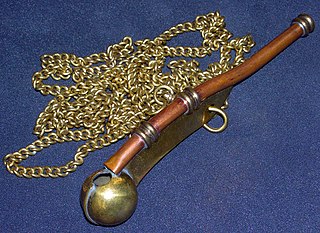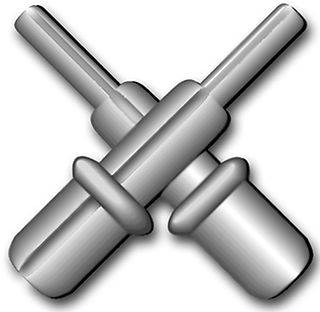| Look up boatswain in Wiktionary, the free dictionary. |
Boatswain is the seniormost rate of the deck department.
Contents
Boatswain or bosun may also refer to:
| Look up boatswain in Wiktionary, the free dictionary. |
Boatswain is the seniormost rate of the deck department.
Boatswain or bosun may also refer to:
| This disambiguation page lists articles associated with the title Boatswain. If an internal link led you here, you may wish to change the link to point directly to the intended article. |

In a navy, a rate, rating or bluejacket is a junior enlisted member of that navy who is not a warrant officer or commissioned officer. Depending on the country and navy that uses it, the exact term and the range of ranks that it refers to may vary.

Petty officer second class is the fifth enlisted rank in the U.S. Navy, U.S. Coast Guard, and the United States Naval Sea Cadet Corps, just above petty officer third class and below petty officer first class, and is a non-commissioned officer. It is equivalent to the rank of sergeant in the Army and Marine Corps, and staff sergeant in the Air Force.

A boatswain, bo's'n, bos'n, or bosun, also known as a Petty Officer, deck boss, or a qualified member of the deck department, is the seniormost rate of the deck department and is responsible for the components of a ship's hull. The boatswain supervises the other members of the ship's deck department, and typically is not a watchstander, except on vessels with small crews. Additional duties vary depending upon ship, crew, and circumstances.
The coxswain is the person in charge of a boat, particularly its navigation and steering. The etymology of the word gives a literal meaning of "boat servant" since it comes from cock, a cockboat or other small vessel kept aboard a ship, and swain, an Old English term derived from the Old Norse sveinn meaning boy or servant.

Quartermaster is a military term, the meaning of which depends on the country and service. In land armies, a quartermaster is generally a relatively senior soldier who supervises stores or barracks and distributes supplies and provisions. In many navies, a quartermaster is an officer with particular responsibility for steering and signals. The seaman is a non-commissioned officer rank; in some others, it is not a rank but a role related to navigation.

A boatswain's call, pipe or bosun's whistle is a pipe or a non-diaphragm type whistle used on naval ships by a boatswain. It is pronounced, and sometimes spelled, "bosun's call".
Seafaring is a tradition that encompasses a variety of professions and ranks. Each of these roles carries unique responsibilities that are integral to the successful operation of a seafaring vessel. A ship's crew can generally be divided into four main categories: the deck department, the engineering department, the steward's department, and other. The reasoning behind this is that a ship's bridge, filled with sophisticated navigational equipment, requires skills differing from those used on deck operations – such as berthing, cargo and/or military devices – which in turn requires skills different from those used in a ship's engine room and propulsion, and so on.

The United States Navy and United States Coast Guard occupational rating of gunner's mate (GM) is a designation given by the Bureau of Naval Personnel (BUPERS) to enlisted sailors who either satisfactorily complete initial Gunner's Mate "A" school training, or who "strike" for the rating by showing competence in the field of ordnance. When "striking" one isn't required to be a seaman, but must belong to one of three undesignated rates: Fireman (FN), Seaman (SN), or Airman (AN). It is also possible cross rate to Gunner's Mate. Cross rating refers to the act of an enlisted sailor "crossing" from their current rating to another rating of their choice, provided their ASVAB scores are high enough and there are open slots for the rate.
A boatswain's mate is a petty officer assisting the boatswain aboard ship.
The Bosun is a 14-foot GRP sailing dinghy originally created for the Royal Navy by designer Ian Proctor and built by Bossoms Boatyard in 1963. The design specification was for a robust dinghy, able to handle open seas, capable of carrying a crew of 3 to 4 people and be fast enough for a competent helm to enjoy sailing, whilst stable enough for a beginner to learn on.

The United States Navy occupational rating of boatswain's mate is a designation given by the Bureau of Naval Personnel (BUPERS) to enlisted members who were rated or "striking" for the rating as a deck seaman. The colloquial form of address for a boatswain's mate is "Boats".

The most versatile member of the Coast Guard's operational team is the boatswain's mate (BM). Boatswain's mates are masters of seamanship. BMs are capable of performing almost any task in connection with deck maintenance, small boat operations, navigation, and supervising all personnel assigned to a ship's deck force. BMs have a general knowledge of lines and cables, including different uses, stresses, strains, and proper stowing. BMs operate hoists, cranes, and winches to load cargo or set gangplanks, and stand watch for security, navigation or communications.

Lieutenant Junior Grade Clarence Samuels, was the first Hispanic American of African descent photographer in the United States Coast Guard, to command a cutter, as well as the first one to be a commanding officer of a Coast Guard vessel during wartime.

Chief petty officer (CPO) is the seventh Enlisted rank in the United States Navy and U.S. Coast Guard, just above petty officer first class and below senior chief petty officer. The term rate is used to identify the career field of a Chief Petty Officer. For example the rate of Master-at-Arms in the rank of Chief Petty Officer would be spoken as Master-at-Arms, Chief Petty Officer or Master-at-Arms Chief. Additionally it would be officially written MAC, USN/R. The grade of chief petty officer was established on 1 April 1893 for the United States Navy. The United States Congress first authorized the Coast Guard to use the promotion to chief petty officer on 18 May 1920. Chief petty officer is also the final cadet grade in the U.S. Naval Sea Cadet Corps.

A sailor, seaman, mariner, or seafarer is a person who works aboard a watercraft as part of its crew, and may work in any one of a number of different fields that are related to the operation and maintenance of a ship.

YP-26 was a former U.S. Coast Guard wooden patrol boat which saw later duty with the U.S. Navy until destroyed in a 1942 accident.